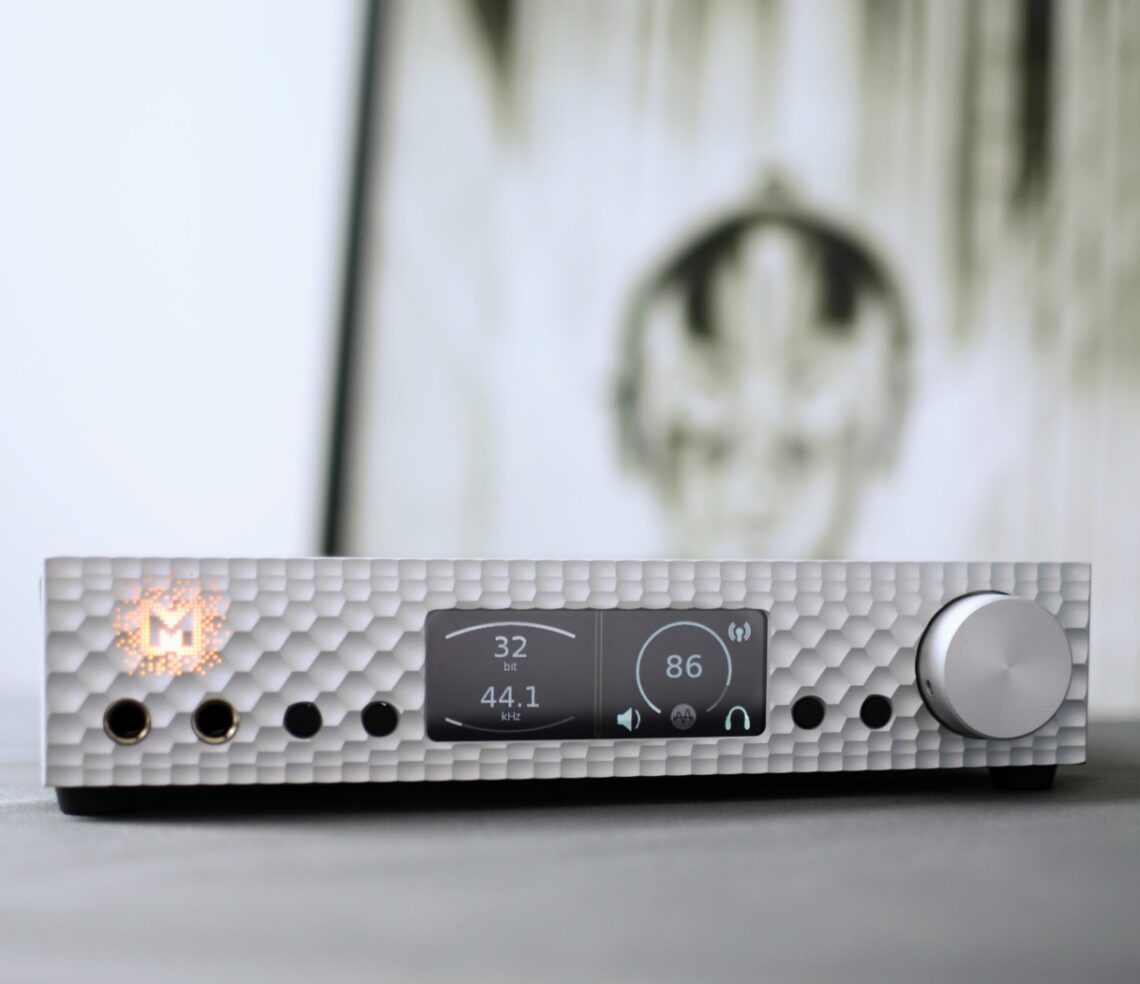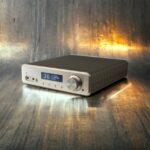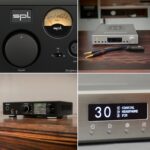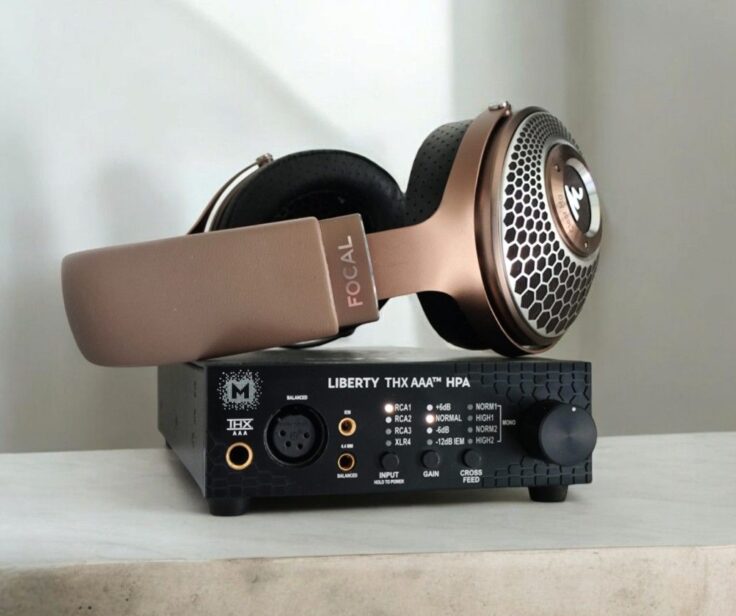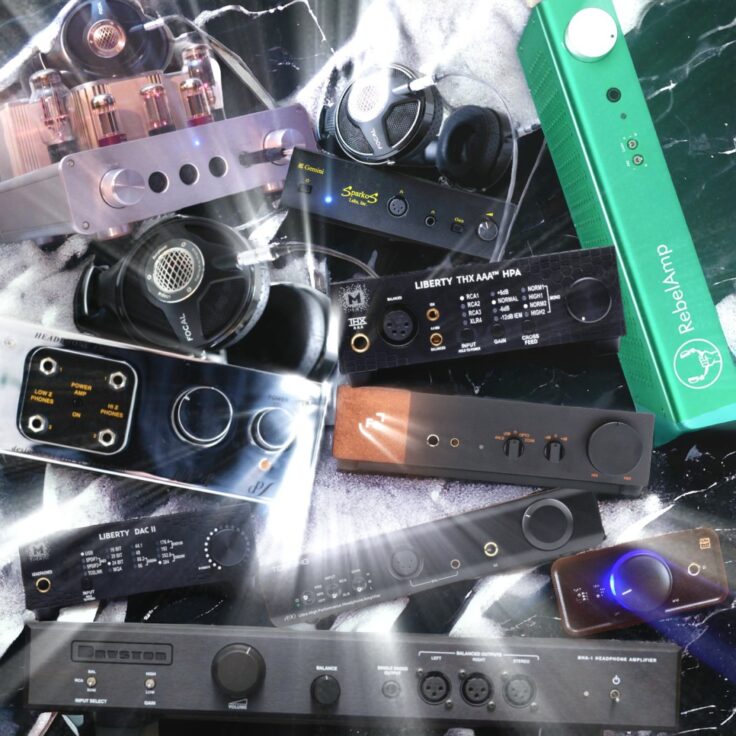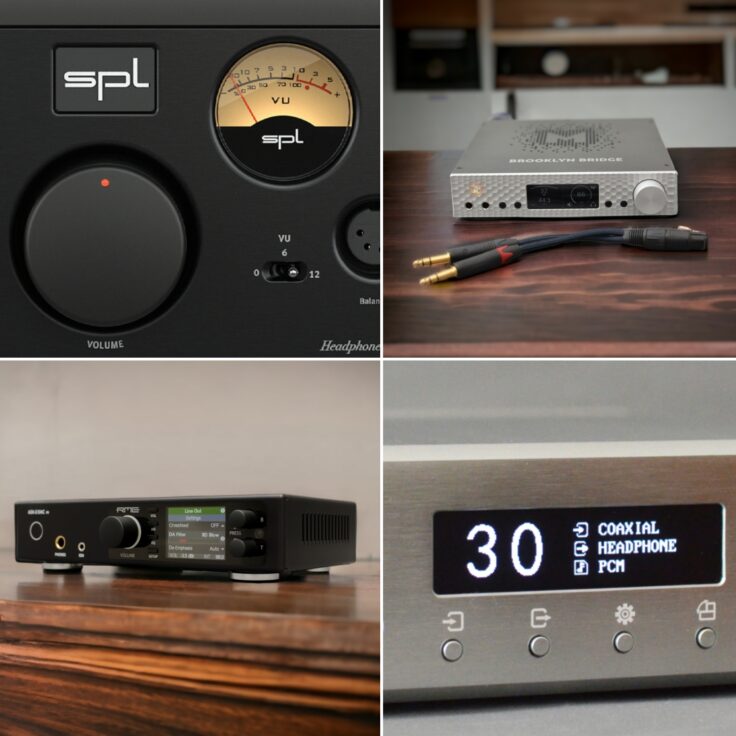I reviewed the original Brooklyn DAC when it came out and was pretty impressed by both the DAC and the headphone amplifier section. The next version, the Brooklyn DAC+, looked practically identical to its predecessor but the internals were not. It featured new DAC hardware with selectable reconstruction filtering options, improved clocking, restyled analogue circuitry and a new powerful headphone amplifier.
Mytek Brooklyn Bridge is basically a Brooklyn DAC+ with a streamer module. It has a LAN network port and a corresponding Wi-Fi antenna. It can be used as an Upnp device or Roon endpoint. So you can consider most of this review a review of both the Brooklyn DAC+ and the Brooklyn Bridge, even though I only have the Bridge at hand.
Even though the internals were redesigned I did not find a very big difference in sound in my unfortunately way too brief comparison between the original Brooklyn DAC and the DAC+/BRIDGE. For practical reasons, I did not get much time with both at the same time. In a fast comparison, it would be hard to tell them apart, in other words, the “house sound” remains similar even though the DAC+ is a little better sounding. The most noticeable difference was the lowered noise floor of the headphone output.
This page is supported by users when they donate or use affiliate links to shop for anything on Amazon via our link here .
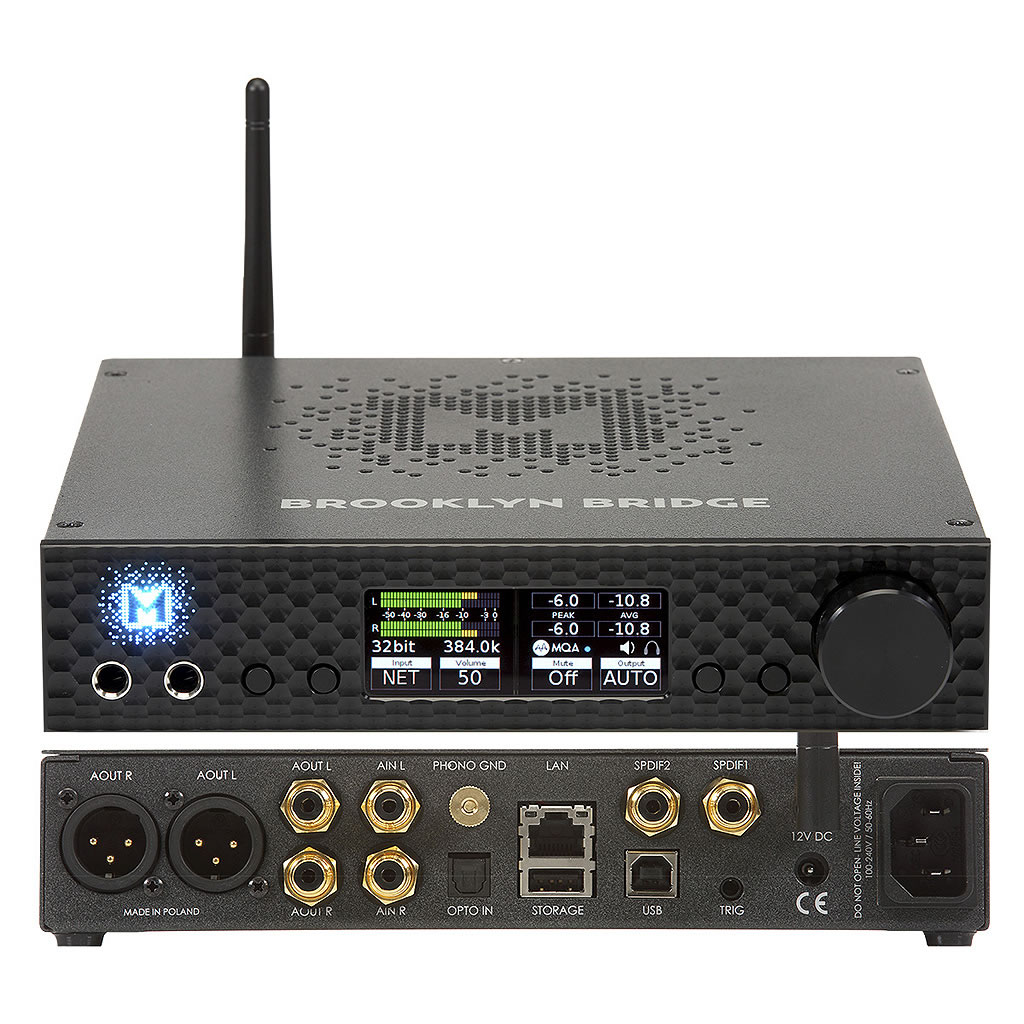
(photos from Mytek)
The Brooklyn Bridge has now been replaced by the Brooklyn Bridge 2. The major difference is that the new version has Roon core built in. If you don’t know Roon, it usually requires that you have your computer or a dedicated server in your house serving the streamers, aka Roon endpoints. With the Mytek Bridge 2 you don’t need that.
That is a very big thing for people who are using Roon. Mytek has actually put a Roon Core capable computer into the already compact chassis of the Brooklyn Bridge, an impressive feat by itself and they also claim that it sounds even better than before. I will let Mytek explain the differences themselves:
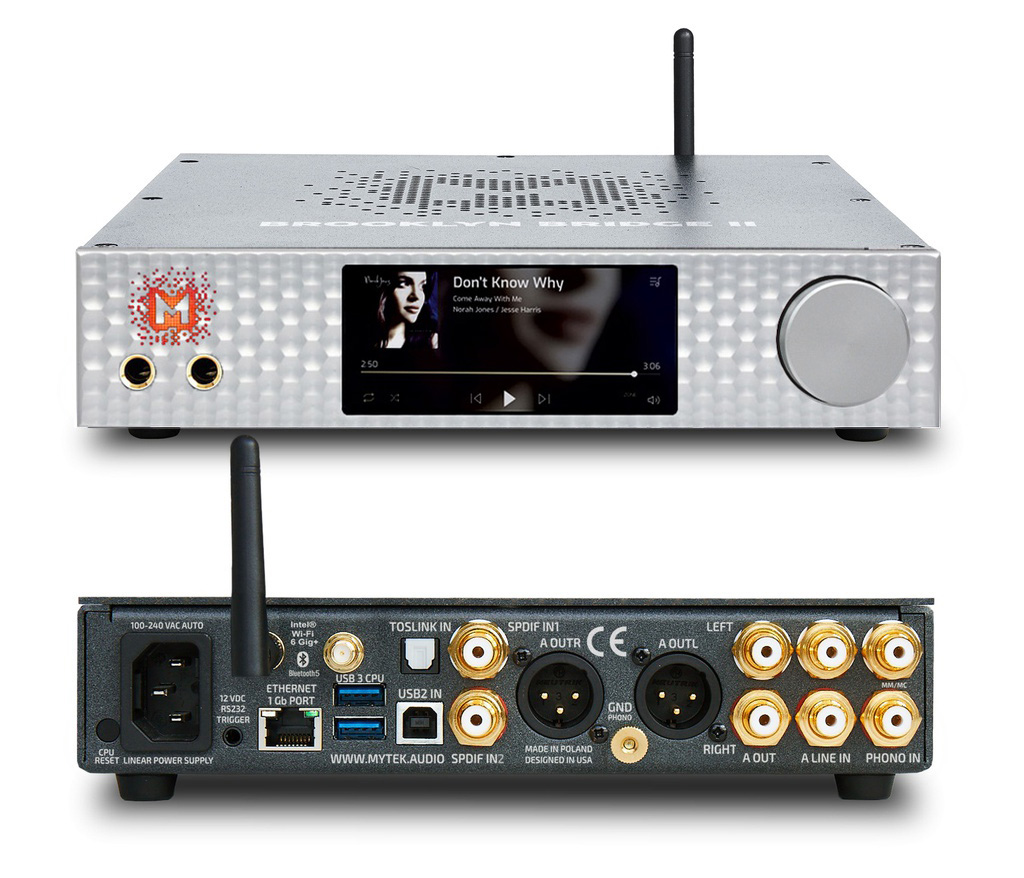
(photos from Mytek)
BROOKLYN BRIDGE II ROON CORE
ALL-IN-ONE • ROON CORE STREAMER • DAC • HEADPHONE • PHONO• PREAMP
Brooklyn Bridge II (BB2) is a major redesign of our best selling original Brooklyn Bridge (BB1). The BB2 now officially has a built-in Roon Core computer combined with Mytek OS for easy touch screen operation from an iPad, smartphone or front panel screen. BB2 is a complete all-in-one Roon system and designed to be used primarily with Roon playback software. In addition, it will provide similar functionality to the original Brooklyn Bridge (Upnp and Roon EndPoint) and more (Bluetooth, DSP etc). You can think of BB1 functionality being a subset of BB2. BB2 has the functionality of BB1 plus Roon Core computer, touch screen, toroidal linear power supply. Because the computer will be continuously updated over the life of the product, a lot of new functionality will be added, including new streaming and DSP options, file management etc., which are not possible nor intended for the BB1. The DAC and analog section is the same in both products, but because BB2 has the linear regulated power supply, it subjectively sounds about 20% better than the BB1.
Using Roon with BB2 requires Roon subscription. Roon provides superior playback and browsing experience, especially with metadata (lyrics, credits, just like a vinyl album covers), not available with other playback software and preferred by thousands of music lovers. Roon also provides more options such as advanced playlist management, multiroom playback and ARC which turns your local library into your own, private streaming service. Roon will play any format including DSD256 and 384k PCM, while other software is limited to max PCM 192k
If you don’t want use Roon, nor Bluetooth and upgradable future functionality, and are happy with standard Tidal or Spotify playback interface which uses Upnp for simple playback, you should consider instead buying the Brooklyn Bridge Original.
As you can see the manufacturer actually recommends considering the old version versus the new if you don’t need the new functionality, so we can assume that the headphone outputs and the DAC performance are in the same ballpark, even though they claim the DAC also sounds better in the B2. My audiophile instincts tell me that putting a computer into a small DAC might induce noise but I must just believe Mytek when they say they have managed to do that and even increased audio quality.
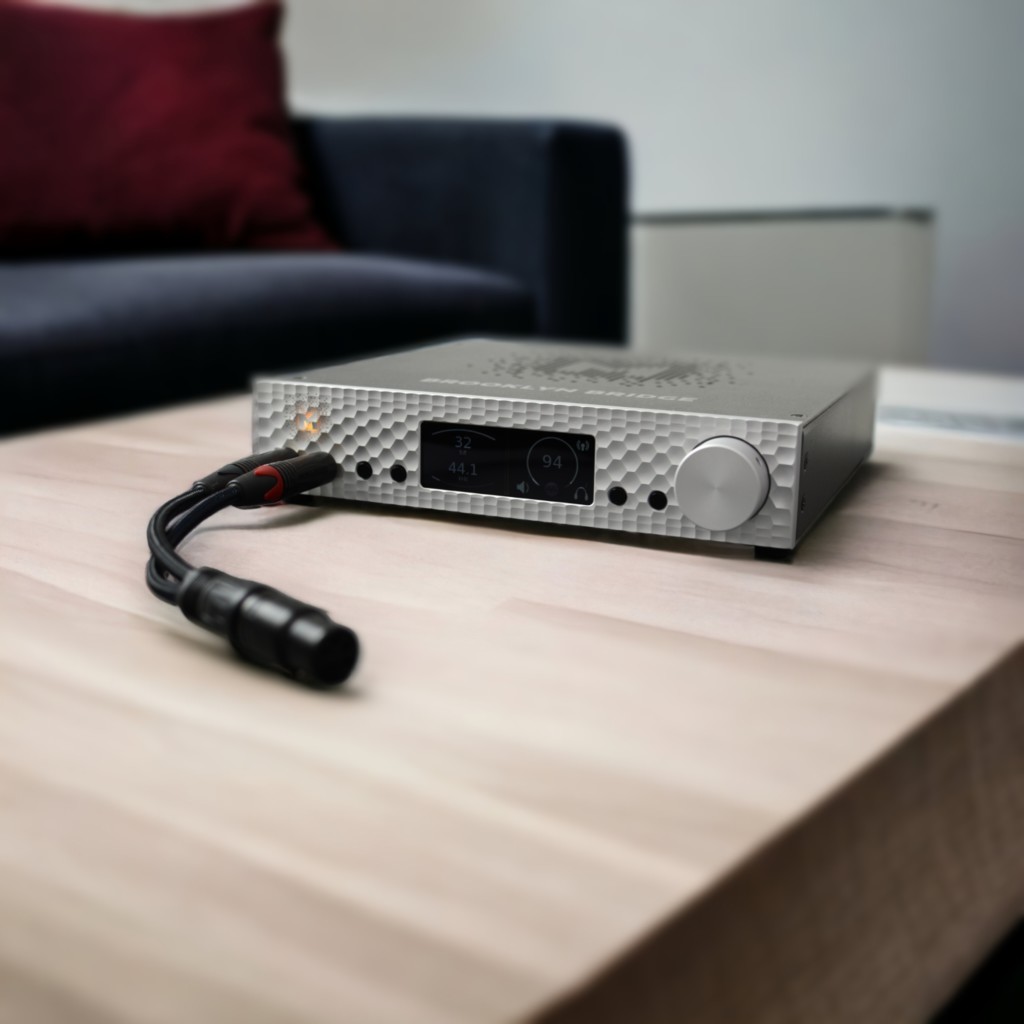
FUNCTIONALITY
The OLED display of the original Mytek Bridge is a beautiful colour display with great contrast. I find the navigation totally acceptable but I would not call the unit “family-friendly”. You navigate with the help of four buttons and the volume wheel. There is an Apple remote control that does the basic functionality. The manual is actually very instructive and with good illustrations so please check it out if you are curious. There is a direct link at the bottom of this article to the manuals of both the Bridge and DAC+.
The unit has balanced and unbalanced line outputs on the back, two headphone outputs on the front. There are USB, AES, COAX and Toslink digital inputs, as well as a LAN port on the Bridge. There is an analogue RCA input that can be used either as a normal analog input or a mm/mc phono input for vinyl lovers.
All the Brooklyns (The Bridge, Bridge 2 and the original DAC and DAC+) offer analogue inputs that can be used with normal line-level analogue sources or as a phono preamp input (MM/MC). The latest Bridge 2 actually has a separate analog line level and phono input. Wow.
To enjoy balanced headphone audio output you need a special cable adapter that connects a female 4 pin XLR to two TRS mono. The explanation is that, as always, balanced headphone output is actually just dual mono operation.
When playing both line output and headphone output at the same time, the volume is also set to be the same. The RME ADI-2 DAC FS in comparison, conveniently remembers the setting for each output channel.
The Brooklyn Bridge is very well integrated with Roon. You can adjust the volume with Roon, and with the latest firmware, you can even see the album cover art playing on the Bridge display. The only thing lacking is a “play/pause” and skip forward/back button.
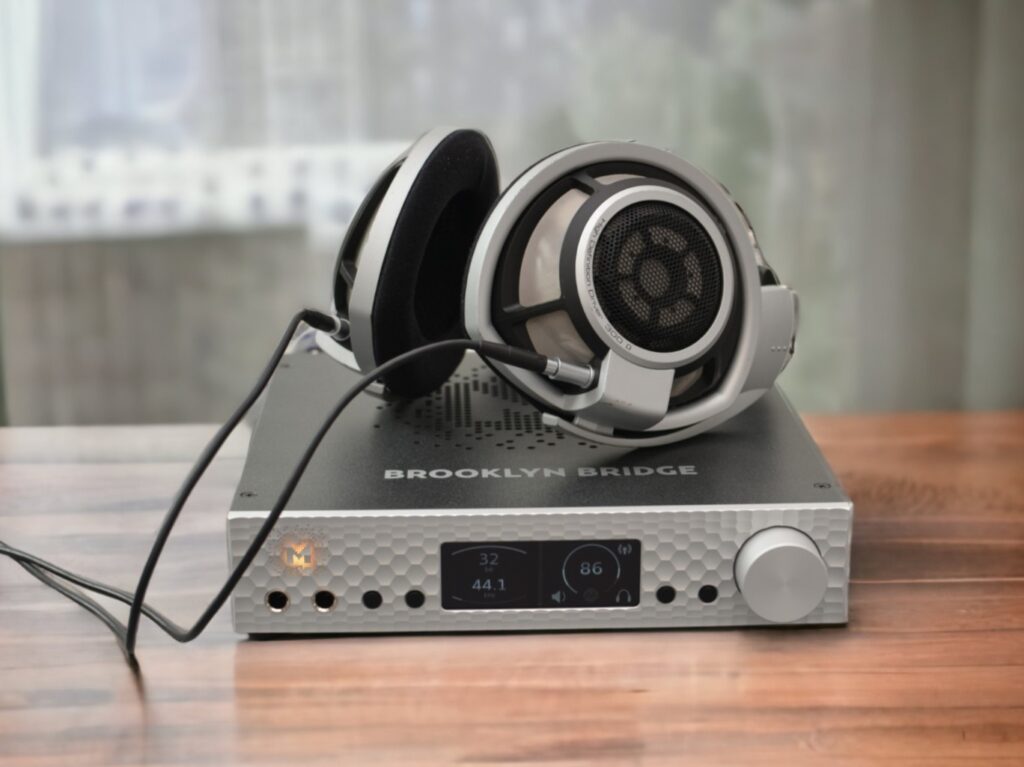
THE SOUND
I was truly impressed with the first Brooklyn DAC and I am very impressed with the Brooklyn DAC+ and Bridge. They offer superb DA conversion, a great pre-amplifier section and impressive results with headphones. I tested the pre amplifier in a simple way by connecting the Brooklyn to my most resolving STAX setup, and I preferred using the Brooklyn as a pre amp (regulating the volume) with the Stax amp pot maxed out.
DAC COMPARISONS
In the following, I will compare the Brooklyn Bridge DAC to other DACs in various setups
MYTEK BRIDGE vs AUDIO GD MASTER 7
The Audio-GD Master 7 DAC has been my main reference for a long time and it fared quite well against the Mytek Manhattan II, even though I preferred the latter. I test the DACs with two setups.
Setup 1 is Audio GD Master 9 amp with HE1000mk2 headphones, LAN input to the Mytek Bridge and Allo USB Bridge transport for the Master 7
The difference between the two DACs is very small. The Mytek delivers a slightly better sense of detail and has an even blacker background. The Master 7 is a tiny bit fuller sounding and as usual, it is mostly noticeable in vocals. But the tonality is surprisingly really similar, which is a very good thing for the Mytek. The Master 7 has the best mid-range smoothness I have heard but now the Mytek is so close that it really is almost insignificant in this setup.
Setup 2 is my Stax rig: STAX SRM-007T2 amplifier and SR-009 headphones. They are very close here too, and honestly, the differences are so small that it is almost boring. The Master 7 still it’s slightly smoother in the mid-range, it is undoubtedly noticeable with Susan Wong’s “Can’t You See”. The Mytek on the other hand is a tad crisper and a tad more spacious with the percussion on the improv jazz trio 1982’s track “3:51”.
Concluding, I am very impressed with the Mytek Bridge’s DAC performance. It comes really close to the Master 7 where the Master 7 is at its best. At the same time, the Brooklyn Bridge is slightly better in raw detail and delivers a little bit more sense of space. I think back to when I reviewed the Mytek Manhattan II. I think I basically described it in almost the same way.
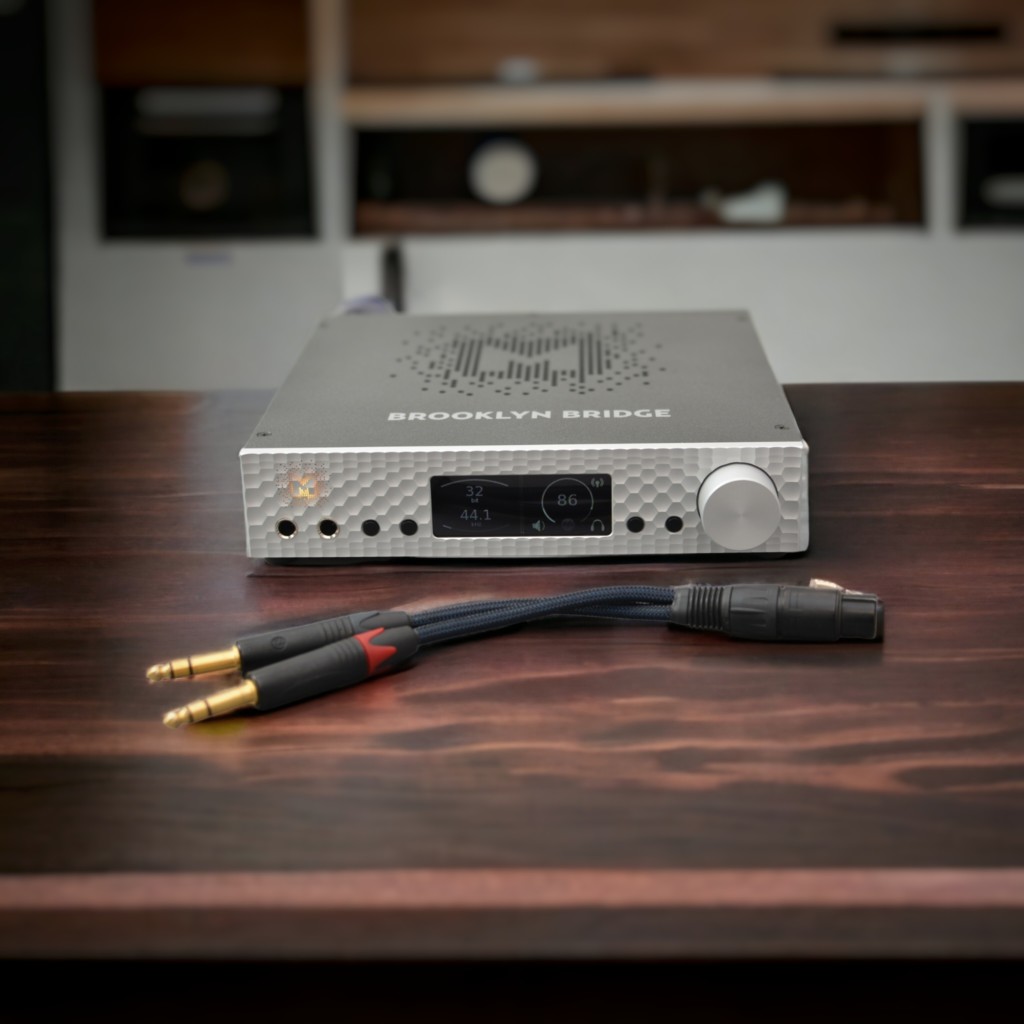
MYTEK BRIDGE vs RME ADI-2 DAC FS
The RME ADI-2 DAC FS is a great performer, especially for the money, and a long-standing reference DAC. I compare the DACs with two setups.
Setup 1: First I used the Master 9 amplifier with HE1000mk2, LAN input to the Mytek Bridge and Allo USB Bridge transport for the ADI-2 DAC FS
Compared to the RME ADI-2 I do feel that the Mytek is a tad more articulated, with a little bit better micro-contrast, notable with things like guitar plucking, certain percussion sounds etc.
So between the RME, the Mytek and the Master 7 the Mytek is a tiny little bit more spacious and crispy with more obvious ultra-fine detail (plankton), The Master 7 is almost on par but has the smoothest and most pleasing midrange tonality. The RME is closer to the Mytek’s tonality but not all the way there in spaciousness and detail. However, I’d say that for 90 percent of the music and probably 99 percent of listeners the differences are so small they can be considered irrelevant.
In other words 90 percent of the listening time they are practically identical. I would guess that in a higher resolution speaker setup, the differences would be more obvious because a speaker setup will always get help from the room in accelerating differences, but for headphone listening these DACs are so close I am happy with all three.
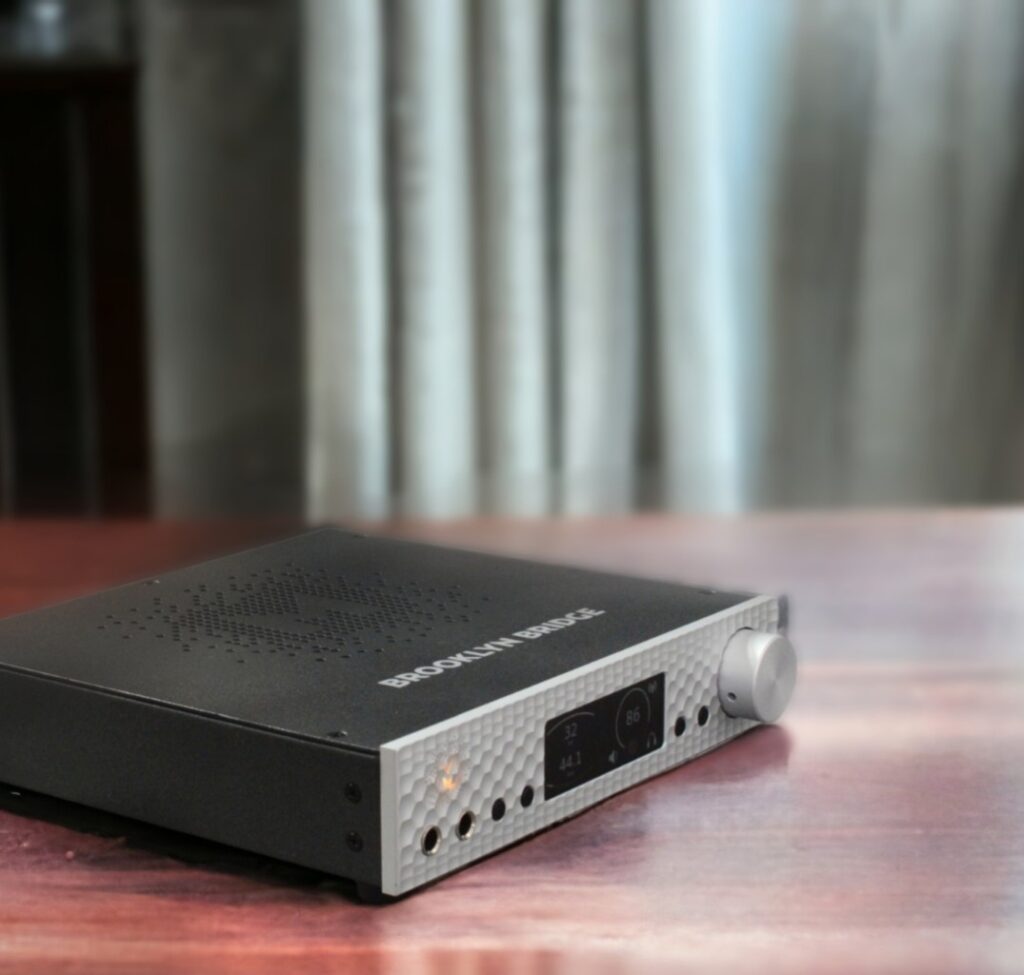
Setup 2: I then compared the DAC section of the Bridge and the ADI-2 by hooking them both up to my Stax SR-009/SRM-007tII setup. I compared them using the streamer input of the Bridge and the USB input of the ADI-2 with the Allo USB Bridge, but also with both DACs fed by a coax/SPDIF signal. The results were consistent no matter the digital input used.
First, I listened to the final part of Mahler’s 2nd symphony and noticed that the Mytek did a tad better with the busy parts. The harp was clearer in the background with the Mytek. Moving on to other music, I tend to find them very similar, but the Mytek sometimes is slightly clearer sounding and offers more resolution with cymbals and other instruments that benefits from a bit extra upper treble resolution. However, they are both brilliant and mostly they are hard to separate even on the very resolving Stax setup.
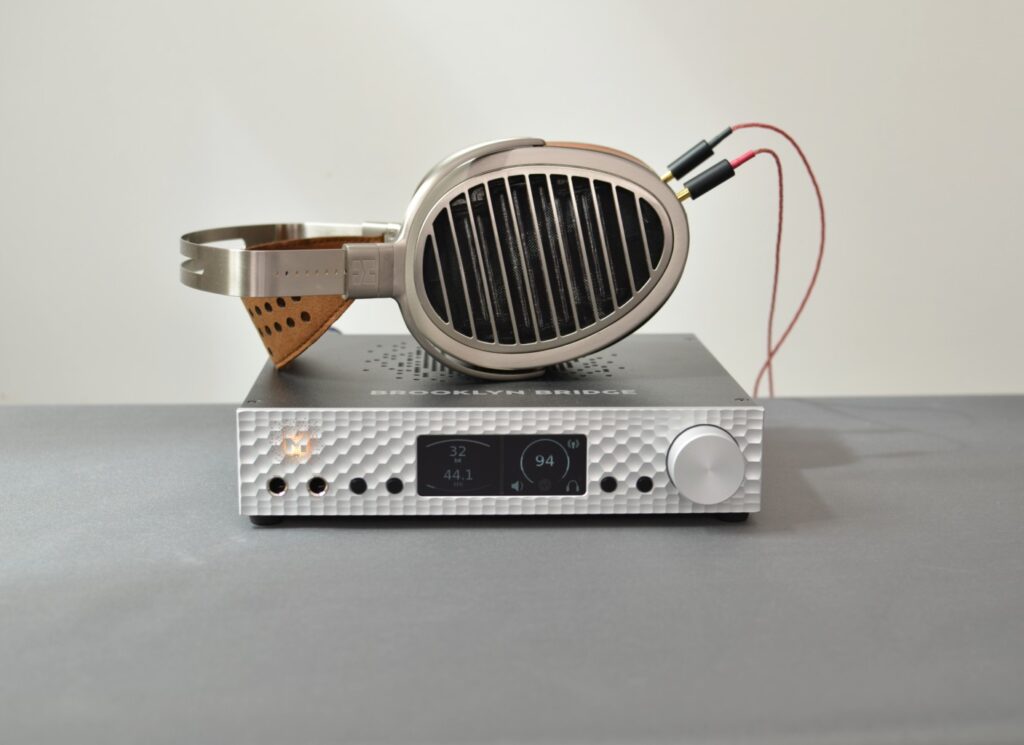
HEADPHONE AMPLIFIER PERFORMANCE
At The Headphoneer we are of course of the opinion that the most interesting part is how Mytek performs with headphones. First I tested it against some of my favorite dedicated headphone amplifiers.
AURALIC TAURUS VS MYTEK BRIDGE
The Taurus is a great amp. Snappy and tight, yet somehow retaining some warmth. I used the Mytek a source for the Taurus.
Comparing the Mytk Bridge to the Taurus with the Hifiman HE1000v2 (balanced) the Taurus is more spacious and dynamic but the Bridge holds up quite well.
With the Sennheiser HD800 (balanced) I find the Mytek to hold up very well too, even though not all the way as good as the Taurus. They both sound snappy and crisp.
The Taurus and the Mytek sound quite similar with the Audeze LCD-3. Both sound great. Crisp and clear but still keeping that LCD-3 smoothness, that nice warm sense of body to the tone. It’s impressive from the Mytek really to hold up almost on the level of the Taurus, which is a great match for the LCD-3.
Also, the Shure SRH-1840 is quite similar with these amps.
Beyerdynamic T1 – I often feel that the Taurus is a bit dry sounding for the T1. They are not that different but I might find the Mytek slightly better. Both offer plenty of punch and headroom, though.
All in all, the Mytek impressed me a lot. Mostly the Taurus came up on top but it was often quite close, and with the T1 I preferred the Mytek.
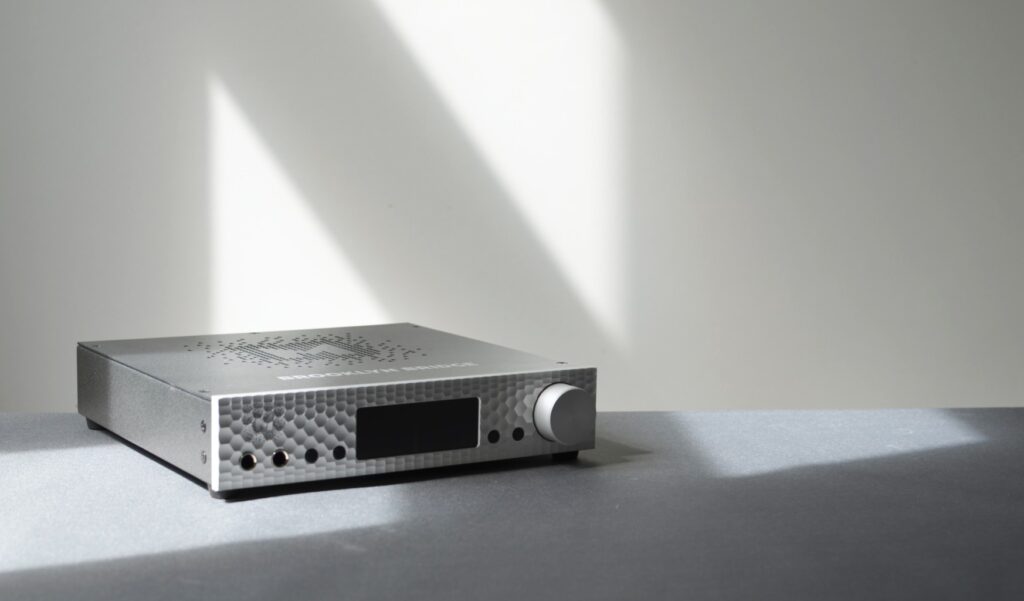
VIOLECTRIC V200 vs MYTEK BRIDGE
Warming up with some warm sounding jazz guitar playing with Jakob Brio Trio´s “So In Love”, I find these to have a very similar sound signature with the Sennheiser HD800. Moving on to the seducing female vocals of “Carratera” with David Brito it becomes apparent that the Mytek has a warmer and fuller sounding midrange. The singer is definitely a bit more polite sounding with the V200. The Mytek also has some extra crispness to steel guitars etc. In terms of general dynamics, headroom and detail, I find them quite similar.
Playing the playful improvisational jazz piece “Full Circle” with the Audeze LCD-X, I tend to find the Mytek to have better articulation and a cleaner background. It feels clearer and more detailed, dynamic and with a satisfyingly full midrange.
With the Hifiman HE-1000v2 on the other hand, starting with “Hellhound on my Trail” by Cassandra Wilson, the V200 seems to have at least as good control as the Mytek. The V200 is smooth but very dynamic, handling the delicious vocals and that crisp steel guitar very well. Moving on with Erlend Dahlen’s “Clocks”, the Mytek does have some more liveliness to those higher frequencies.
With the Elear (unbalanced) I think the V200 feels a bit more open and engaging sounding than the Mytek.
Again the Mytek compares very well against a dedicated headphone amp. I am impressed.
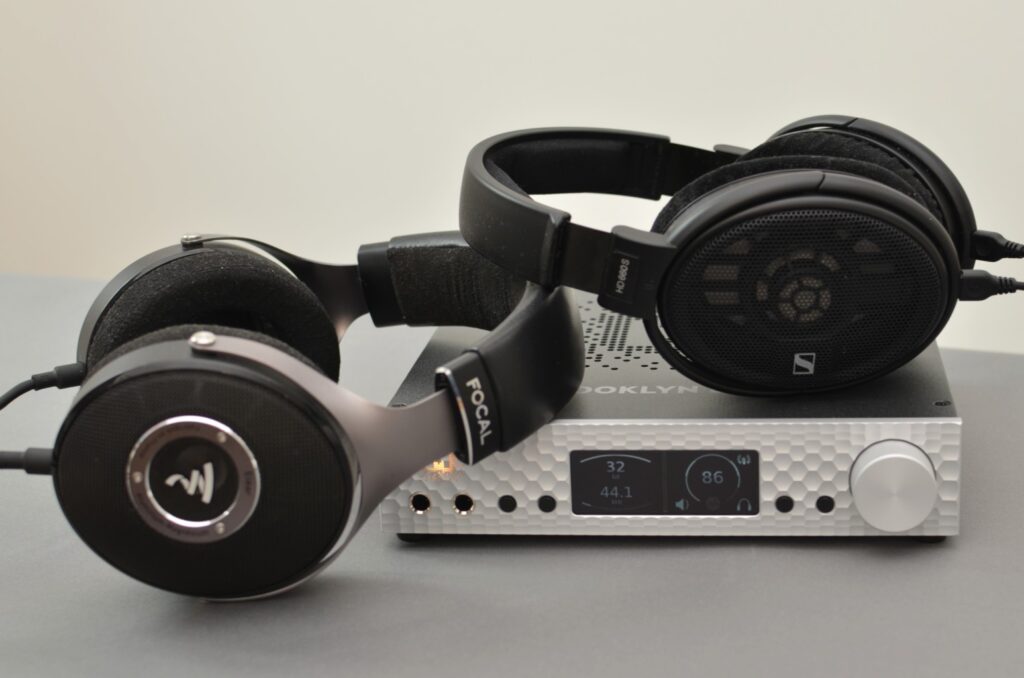
DAC/AMP COMPARISONS
RME ADI-2 DAC FS VS MYTEK BRIDGE
One of the most interesting competitors to the Mytek DAC+ / Bridge as a DAC/amp is the RME ADI-2. The RME is known to punch about its weight both as a DAC and a headphone amplifier.
FUNCTIONALITY
Compared to the ADI-2, the Brooklyn DAC+ and Brooklyn Bridge have an advantage in that it has an analogue and turn-table ready input and a corresponding analogue volume control. The Bridge, in addition, of course, has the streamer module.
The RME ADI-2 DAC FS offers built-in EQ and other DSP functions. Further, when playing both line output and headphone output at the same time, the volume is set to be the same for both outputs with the Myteks, so you must manually readjust. The RME ADI-2 DAC FS, in comparison, conveniently remembers the setting for each output channel.
The RME ADI-2 also has a much lower noise floor and is suitable with low-sensitivity headphones. It even has a 3.5mm IEM output. However, it does not offer balanced operation but it is quite powerful nonetheless.
In my comparison between the Mytek and the RME, I had the Phonitor xe at hand. So I threw that in the ring too:
RME ADI-2 DAC FS, MYTEK BRIDGE/DAC+ AND SPL PHONITOR xe COMPARED
In this round, I compare all three units as DAC/amps. That means that I am using the internal DA converters on all units. I sometimes used the balanced outputs of both the Mytek and Phonitor. The RME is always unbalanced by design. I indicate where I use balanced or unbalanced outputs on the Mytek and the Phonitor.
Sennheiser HD800 balanced
Starting out with some Bach Cello Concerts, the ADI-2 and Brooklyn are not dissimilar, and both are very good. I feel Mytek is a bit cleaner. They do not offer the warmth and fullness of my most cherished HD800 amps, and comparing them to the Phonitor xe, it is obvious my memory isn’t failing me: The Phonitor does sound better.
Moving on to more experimental music, (In Touch – Yves Robert et.al.) ADI-2 and Brooklyn are again very similar. They share the same clean, but slightly analytical presentation. Compared to the Phonitor, they lack some warmth and fullness but also some sense of image depth.
With “There, There” by Radiohead, the ADI-2 is a bit softer, I notice Thome Yorke’s vocals having a bit more raspiness and edge with the Brooklyn. Compared to the Phonitor, again, they both fall a bit short.
All in all, the ADI-2 and Brooklyn Bridge have more in common than what separates them. I do find the Mytek a tiny bit clearer, but on the other hand, the HD800 can happily accept some EQ-ing, and that is something the ADI-2 does offer in-house.
Hifiman Sundara unbalanced
Also with the Sundara, I find the difference small but the Bridge is still slightly crisper and clearer than the ADI-2. And as with the HD800, moving to the Phonitor makes a positive difference, especially with regards to the sense of body, openness and just a more pleasing and organic feeling.
Sennheiser HD650 and HD660S unbalanced
Brooklyn and ADI-2 again sound quite similar with the HD650, both are great. The Phonitor is even better. The HD660S gives the same result.
Hifiman HE1000v2 balanced
The Mytek is surprisingly good with the HE1000v2. Really great. Almost as good as the Phonitor. The HE1000v2 is a hard headphone to drive properly, but the Mytek does a great job indeed. The ADI-2 is not bad, but a bit less exciting and bold sounding than the other two.
LCD-3 balanced
Driving the LCD-3 is a much more even game. The Mytek and the Phonitor are quite similar, the ADI-2 is still good but a tad flatter sounding, lacking a bit of presence in the mid-range – at least in comparison.
Fostex TH900 unbalanced
The Mytek does have a very slight background hiss with these cans, but a lot less than I remember the predecessor had, and it is absolutely listenable. Other than that, they sound great. The ADI-2 has a similar hiss when “Hi-Power” mode is on, but not when it is disabled. That being said, I do prefer the Mytek, despite the slight hiss. It is more dynamic and lively sounding. The Phonitor has no hiss and is better than both.
All in all, both the ADI-2 and the Mytek Bridge/DAC+ have excellent headphone amplifier sections. They present lots of detail and authority. Often, they perform similarly well, but when one of them stands out, it is the Mytek. It is a bit more punchy and has livelier mids. Both have lots of power and offer a spacious and detailed presentation. The Phonitor xe, however, often seems to give me a better headphone experience. It is not about it being more detailed, it’s about the way it presents the flesh and soul of by the music.
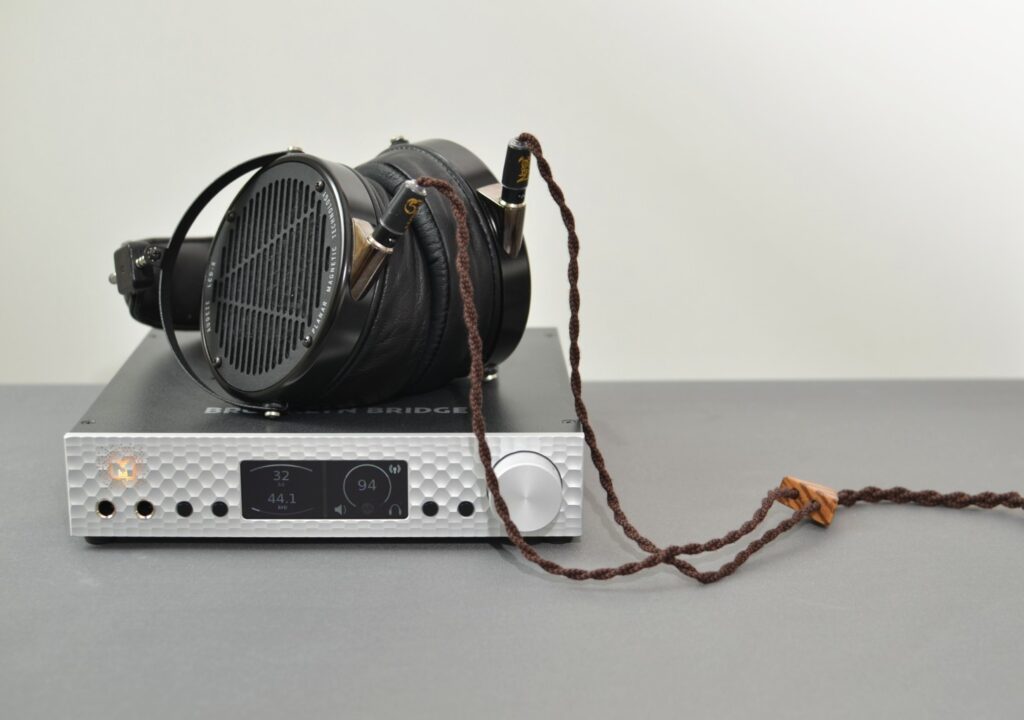
BURSON CONDUCTOR 3 REFERENCE VS MYTEK BRIDGE and DAC+
The final test for the Mytek Bridge is the Burson Conductor 3 Reference. I consider the Burson an amplifier first and foremost, but it has a great DAC too. I have reviewed it recently here on The Headphoneer. The internal DACs were used for this comparison.
With Audeze LCD-3 the Burson is slightly more rounded and organic and natural sounding even though the mytek really does a good job. Switching over to the HD800, it becomes apparent that although they often sound quite similar, the Burson does indeed have a sweeter tonality, with electric jazz guitars and such, it has a better ability to convey that tubey glow. Moving on to the Shure SRH-1840, the difference remains the same. Both drive these headphones very well, but the Burson has that slight extra glow.
The Hifiman HE-1000 sounds smoother, more organic and refined with the Burson. The Bridge is very good, it’s dynamic and spacious but feels a bit drier. It’s a matter of preference, maybe.
With the Beyerdynamic T1, I find the Burson a bit more to my liking. Both amps drive these headphones well, but the extra bit of sweetness from the Burson suits the T1.
Starting out with the Grand Central by Thomas Stanko on the Focal Elear (unbalanced), I feel that the Burson is a bit more alive. The trumpet is slightly more organic, the percussion stands out a bit more. Simply put, the Mytek seems to be a little bit flatter sounding with the Elear. It’s still good, the Burson is just a bit better.
The Audeze LCD-X is good on both but I tend to find the Burson a tad more organic sounding.
Finally, the Oppo PM1 (balanced) sounds delicious with the Burson. Erland Dahlen’s “Clocks” is powerful, smooth, lively and inviting. The bass is solid, the bells are very natural sounding. In direct comparison, there is a little something lost when moving over to the Mytek. It sounds good by itself, but in direct comparison, the music becomes flatter sounding. The bells are less alive. These impression remains the same with other songs.
Even though I must say that the Burson is my favourite, the Mytek does a really good job. To quote Currawong: “Comparison is evil”: The Mytek is very enjoyable by itself.
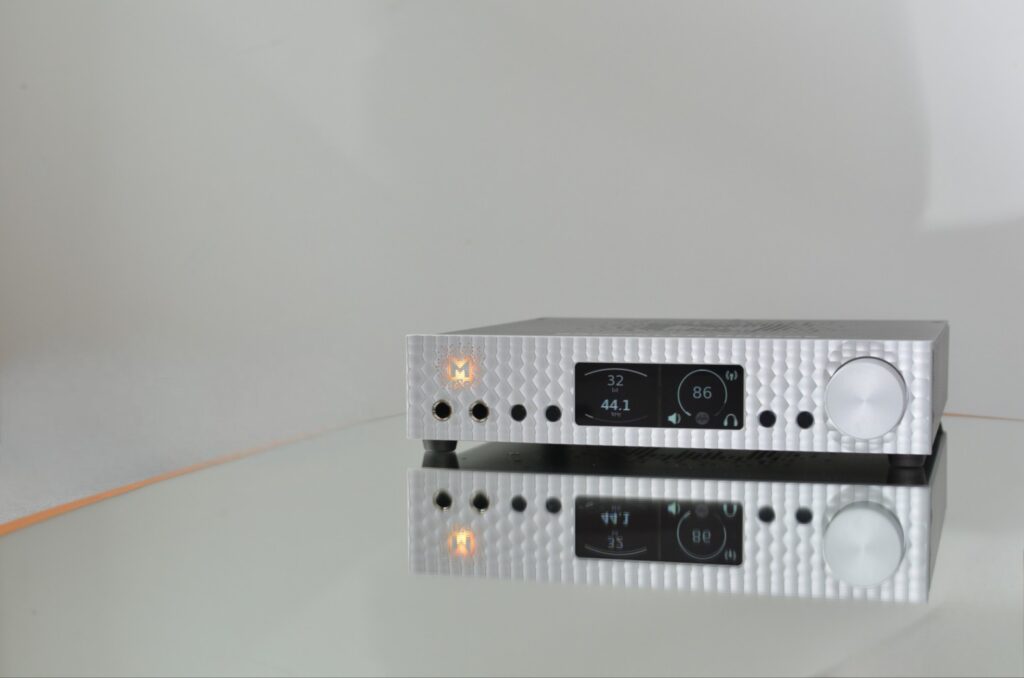
CONCLUSION
The Mytek Brooklyn DAC+ and the Mytek Brooklyn Bridge are stellar DACs and perform extremely well with headphones. The Bridge’s built-in streaming module sounds terrific and integrates beautifully with Roon.
Both the Brooklyn DAC+ and the Brooklyn Bridge come highly recommended. It’s a shame they are discounted, the audiophile world deserves some cheaper options from Mytek if they don’t need the Roon Core equipped Brooklyn Bridge 2.
If you enjoyed this article or other content on The Headphoneer, you might consider leaving a small donation to keep this website up and running. No donation is too small. Thanks for supporting us!
If you like our work please follow us on Instagram, Facebook and Twitter , it will help us grow. Sharing is caring 🙂
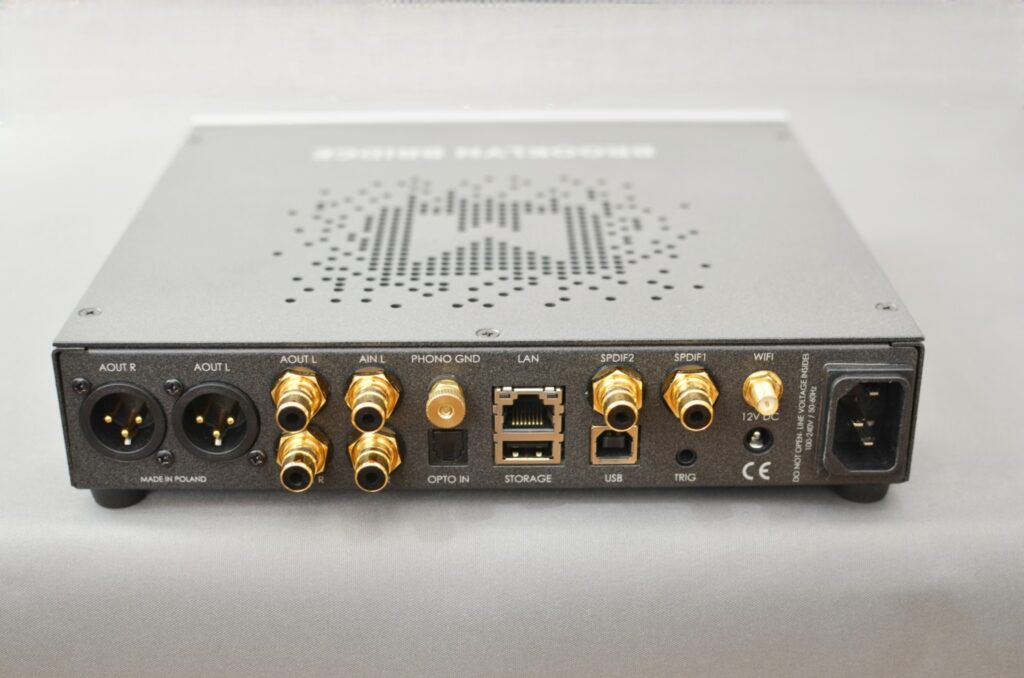
SPECIFICATIONS
ANALOG:
• Analog Outputs Connectors: 2 XLR balanced outputs, 2 RCA unbalanced outputs
• XLR signal output – 1,22V RMS @ -18 dBFS / 9,75V RMS @ 0 dBFS
• RCA signal output – 0,61V RMS @ -18 dBFS / 4,875V RMS @ 0 dBFS
• Resolution DA: PCM 32bit / DSD up to 256 (11.2 Mhz)
• PCM Sample Rate: 44,1 / 48 / 88,2 / 96 / 176,4 / 192 / 384 kHz
• Dynamic Range: 120dB A-weight
• Output Impedance: 75 Ohm
• Headphone Amp: more than 500mA, 6 Watts, 1,22V RMS @ -18 dBFS / 9,75V RMS @ 0 dBFS
• High Current, High Slew Rate ultra-low distortion, balanced
• Built-in Analog Preamp: Line level input or Phono M/M, M/C input, relay controlled
DIGITAL:
• Computer Audio I/O: USB 2.0 Hi-Speed, data stream up to 480Mbits/384kHz, Native DSD up to DSD256, Type B
• Network: RJ-45 connector, PCM up to 24Bits / 192.0kHz, DSD up to x64 (DoP)
• S/PDIF Optical Input (Toslink): up to 176.4kHz, DSD x64
• S/PDIF Coaxial Input 1 & 2: PCM up to 24Bits / 384.0kHz, DSD up to x128 (DoP)
• Clock: Mytek Femtoclock Generator ™ 0.82ps internal jitter
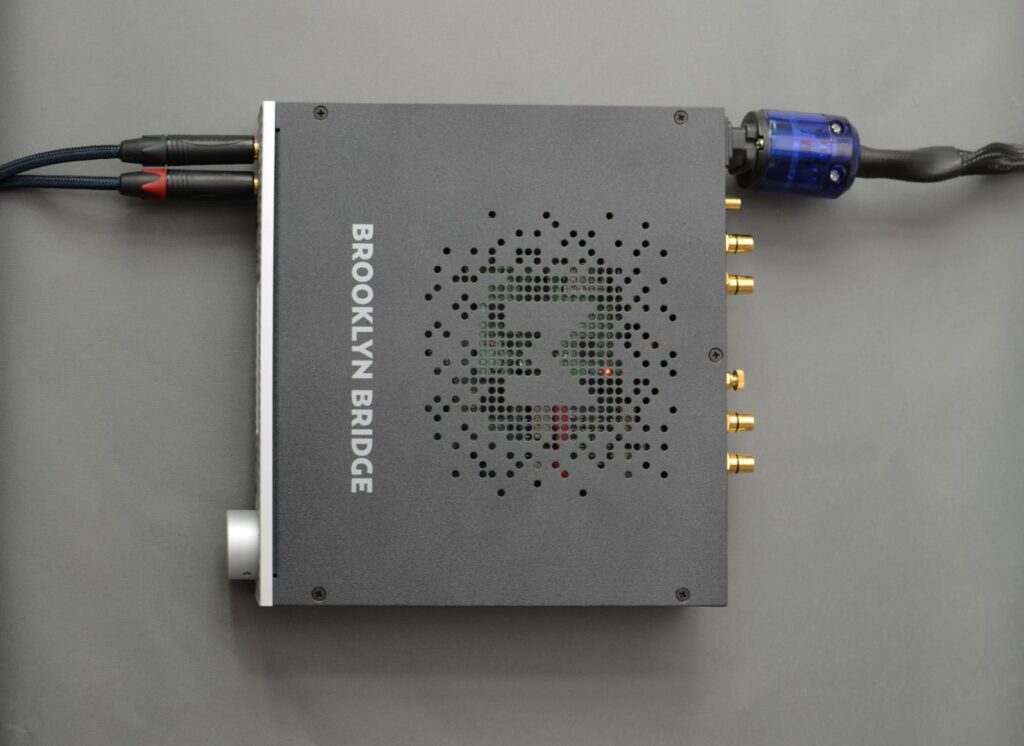
MANUALS
Mytek Brooklyn Bridge
Mytek Brooklyn DAC+


